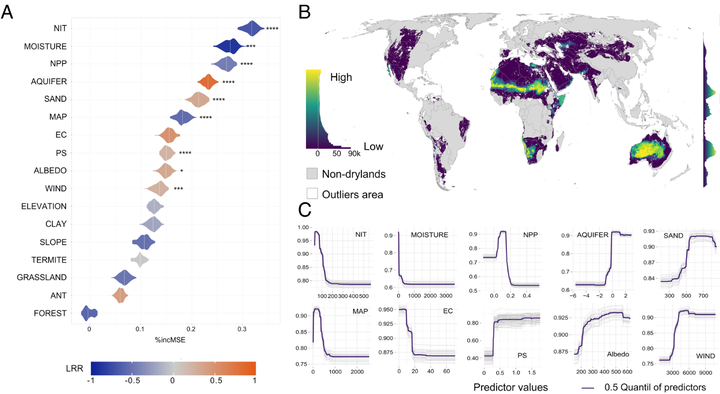 Fig. 2. Relative importance of the drivers of FC-like vegetation patterns (A) and probability of finding FC-like vegetation patterns across global drylands (B). Panel (A) shows the relative contribution of environmental drivers that predict the distribution of FC-like vegetation patterns and their weights. Partial dependence curves (quantile 0.5) for environmental drivers with significance above the median are shown in panel (C). Values close to 1 on the y- axis indicate values of the predictor where FC- like vegetation patterns would be expected. *P ≤ 0.05; **P ≤ 0.01; ***P ≤ 0.001; ****P ≤ 0.0001. Abbreviations can be found in SI Appendix, Table S4.
Fig. 2. Relative importance of the drivers of FC-like vegetation patterns (A) and probability of finding FC-like vegetation patterns across global drylands (B). Panel (A) shows the relative contribution of environmental drivers that predict the distribution of FC-like vegetation patterns and their weights. Partial dependence curves (quantile 0.5) for environmental drivers with significance above the median are shown in panel (C). Values close to 1 on the y- axis indicate values of the predictor where FC- like vegetation patterns would be expected. *P ≤ 0.05; **P ≤ 0.01; ***P ≤ 0.001; ****P ≤ 0.0001. Abbreviations can be found in SI Appendix, Table S4.
Abstract
Fairy circles (FCs) are regular vegetation patterns found in drylands of Namibia and Western Australia. It is virtually unknown whether they are also present in other regions of the world and which environmental factors determine their distribution. We conducted a global systematic survey and found FC-like vegetation patterns in 263 sites from 15 countries and three continents, including the Sahel, Madagascar, and Middle-West Asia. FC-like vegetation patterns are found in environments characterized by a unique combination of soil (including low nutrient levels and high sand content) and climatic (arid regions with high temperatures and high precipitation seasonality) conditions. In addition to these factors, the presence of specific biological elements (termite nests) in certain regions also plays a role in the presence of these patterns. Furthermore, areas with FC-like vegetation patterns also showed more stable temporal productivity patterns than those of surrounding areas. Our study presents a global atlas of FCs and provides unique insights into the ecology and biogeography of these fascinating vegetation patterns.